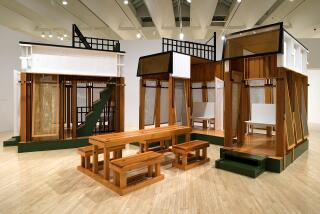DANCE VIDEOS LAUNCH ‘ARTS FOR TV’
- Share via
“The Arts for Television,” a six-part, six-week series of programs organized by the Museum of Contemporary Art in Los Angeles and the Stedelijk Museum of Amsterdam begins in MOCA’s Ahmanson Auditorium today at noon with nearly four hours of dance videotapes.
Varied and provocative, the program generally addresses dance as a visual (rather than kinetic) art and emphasizes novel backgrounds or environments for dancing.
In “Waterproof” (1986), for instance, Jean-Louis Le Tacon takes cameras into a swimming pool with members of the Compagnie Astrakan, showing performers merging with their reflections or looking monstrous because of the optical distortion that water imposes.
“Merce by Merce by Paik” (1975) superimposes Merce Cunningham solos on tracking shots of city streets. It also introduces multiple Cunninghams, whimsical interview and documentary segments (edited to achieve maximum discontinuity) and other caprices of Cunningham, Nam June Paik, Shigeko Kubota and Charles Atlas.
Like his widely seen “Hail the New Puritan,” Atlas’ new “Ex-Romance” is a rambling pseudo-documentary. It alternates vibrant pop dances by Karole Armitage (most of them shot at an airport) with fictionalized evocations of her personal life. A fatuous interview provides an ironic framing device.
A relatively conventional documentary outlook pervades “Dancing on the Edge” (1981). It features Trisha Brown talking about her choreography followed by sequences showing the dances. However, the visual trickery and flamboyant manipulation of stage dancing is almost nonstop.
Unorthodox editing techniques are used more subtly by Marie Andre in “Repetitions” (1984) to chronicle subjectively the long evolution of a stage work by Belgian choreographer Anne Teresa de Keersmaeker. Unfortunately, the revealing interview segments are in French, without subtitles.
Of the dances created for video, May Lucier’s new “If I Could Fly, I Would Fly” fills the screen with just the torsos of Elizabeth Strebb’s dancers and develops from this depersonalized imagery a powerful statement about surrender to gravity--and eventual triumph over it.
“Lament” (1985) uses stark black-and-white photography, pools of water and the nude bodies of postmodern dancers Eiko and Koma to achieve haunting, sculptural abstraction. James Byrne collaborated with the dancers.
In contrast, “Visual Shuffle” (1986) by John Sanborn, Mary Perillo and Charles Moulton obliterates dancing with diversionary special effects. Video fans applaud this sort of thing because it endows the media director-as-wizard with ultimate powers. To dance devotees, it is utterly beside the point.
“Portrait,” a short 1983 work by Dutch choreographer Hans van Manen, is also on the program but was not made available for review.
Screenings for the series (which will focus upon music, theater and other disciplines in future weeks) are scheduled at noon each Tuesday, Wednesday, Thursday and Friday; at 6 p.m. on Friday (abbreviated program), and at 11 a.m. on Saturday and Sunday.
Tickets are free with regular museum admission. Information: (213) 628-6828.
More to Read
The biggest entertainment stories
Get our big stories about Hollywood, film, television, music, arts, culture and more right in your inbox as soon as they publish.
You may occasionally receive promotional content from the Los Angeles Times.










